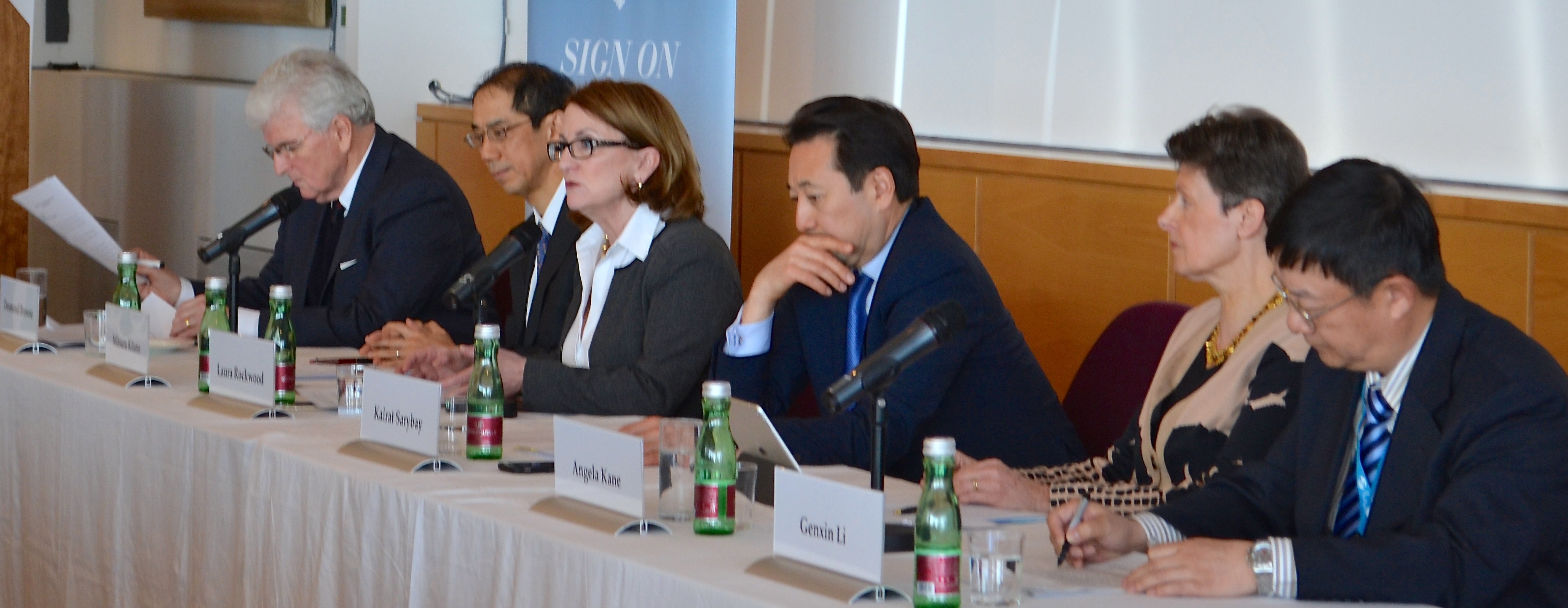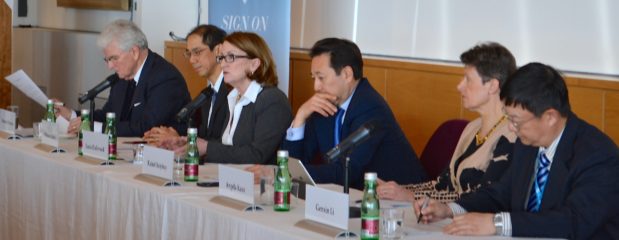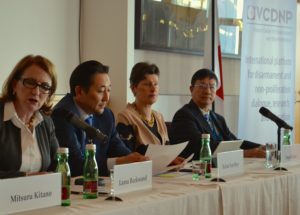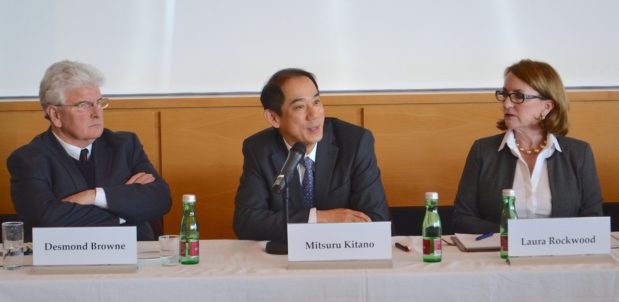
On 10 May 2017, the VCDNP, the Permanent Mission of Japan and the Permanent Mission of Kazakhstan held a high-level panel discussion on "Achieving the Entry into Force of the Comprehensive Nuclear-Test-Ban Treaty (CTBT)." The five panelists were: Ambassador Mitsuru Kitano, Permanent Representative of Japan; Ambassador Kairat Sarybay, Permanent Representative of Kazakhstan; Genxin Li, Director of Legal and External Relations, Comprehensive Nuclear-Test-Ban Treaty Organization (CTBTO); and Members of the CTBTO’s Group of Eminent Persons Angela Kane, VCDNP Senior Fellow, and Lord Desmond Browne, Chair of the European Leadership Network and Vice Chairman of the Nuclear Threat Initiative. The discussion was moderated by Laura Rockwood, VCDNP Executive Director, and followed by a question and answer period.

This was one of the last events in which Ambassador Kitano and Ambassador Sarybay will take part as co-coordinators of the CTBT Article XIV Conferences aimed at facilitating the entry into force of the Treaty before the role is taken over this Fall by the governments of Belgium and Iraq. On the occasion of the 2017 Preparatory Committee meeting for the 2020 Review Conference of the Parties to the Treaty on the Non-Proliferation of Nuclear Weapons (NPT) held in Vienna, the Foreign Ministers of Japan and Kazakhstan and Lassina Zerbo, CTBTO Executive Secretary, issued a Joint Appeal deploring North Korea’s nuclear tests and calling for the early entry into force and universalization of the CTBT.
At the 10 May event, both Ambassadors stated that their governments would continue to provide tangible support to this cause given their nuclear legacies. They encouraged the next co-coordinators of the Article XIV Conference to be imaginative in coming up with new ideas to promote the CTBT. Ambassador Sarybay referred to the importance of utilizing movies to communicate the humanitarian impacts of nuclear weapons and recalled the screening of the documentary “Where the Wind Blew,” jointly co-hosted by the VCDNP and the CTBTO on 10 April 2017. Ambassador Kitano stressed that, even though the provisions of the CTBT had become an almost universally recognized norm, the Treaty should not remain “unfinished business.”
The panel discussion followed a closed meeting which took place at the VCDNP before the public event. Daryl G. Kimball, Executive Director of the Arms Control Association, and Gaukhar Mukhatzhanova of the VCDNP presented summaries of the two sessions in the morning meeting. The first session highlighted the need to understand the specific reasons the remaining Annex II States have yet to sign or ratify the CTBT. The second session, devoted to public outreach, emphasized the importance of disarmament and non-proliferation education and the need to involve the youth in both advocacy and analytical work on nuclear weapons issues. The VCDNP, the Permanent Mission of Japan and the Permanent Mission of Kazakhstan have published a more detailed report on the proceedings of these discussions.
 Mr. Li described the work of the CTBTO’s International Monitoring System (IMS) and International Data Centre. He recalled that achieving a global prohibition on testing had been an objective of the international community since the dawn of the nuclear age. The CTBTO has not only proven its ability to conduct on-site inspections through its field trials, but has also provided data with numerous scientific applications in other areas, such as earthquake and tsunami detection and radionuclide dispersion tracking. Ms. Kane appealed to the non-ratifying Annex II States not to wait for each other to act, and pointed out that China, which lately appeared more willing to act independently, might be the one to take the lead in ratifying the CTBT. According to Ms. Kane, the international community should take advantage of every opportunity to promote the cause of the CTBT. She stressed the contribution that could be made by the younger generation in organizing meetings to help raise awareness. Lord Browne expressed his concern about the current generation of politicians, who, in his view, have little or no knowledge about nuclear weapons. As a GEM member, he intended to focus his efforts on Europe and the Organization for Security and Cooperation in Europe, an organization whose members are all party to the CTBT with a view to encouraging them to talk to their capitals about what they were doing to promote the entry into force of the CTBT to increase pressure on those that have not. He would encourage them to recall the reasons their governments had decided to join the CTBT in the first place, to re-ignite the conversation that led to their ratification of the Treaty and use this dialogue to put pressure on the remaining Annex II States.
Mr. Li described the work of the CTBTO’s International Monitoring System (IMS) and International Data Centre. He recalled that achieving a global prohibition on testing had been an objective of the international community since the dawn of the nuclear age. The CTBTO has not only proven its ability to conduct on-site inspections through its field trials, but has also provided data with numerous scientific applications in other areas, such as earthquake and tsunami detection and radionuclide dispersion tracking. Ms. Kane appealed to the non-ratifying Annex II States not to wait for each other to act, and pointed out that China, which lately appeared more willing to act independently, might be the one to take the lead in ratifying the CTBT. According to Ms. Kane, the international community should take advantage of every opportunity to promote the cause of the CTBT. She stressed the contribution that could be made by the younger generation in organizing meetings to help raise awareness. Lord Browne expressed his concern about the current generation of politicians, who, in his view, have little or no knowledge about nuclear weapons. As a GEM member, he intended to focus his efforts on Europe and the Organization for Security and Cooperation in Europe, an organization whose members are all party to the CTBT with a view to encouraging them to talk to their capitals about what they were doing to promote the entry into force of the CTBT to increase pressure on those that have not. He would encourage them to recall the reasons their governments had decided to join the CTBT in the first place, to re-ignite the conversation that led to their ratification of the Treaty and use this dialogue to put pressure on the remaining Annex II States.
 During the question and answer period, the activities of the CTBTO Youth Group were highlighted along with the need for the CTBT State signatories to take more concrete action in promoting the Treaty’s entry into force. Much attention was paid to innovative ways to educate the public by, for example, connecting students around the world and creating easily accessible online modules. In conclusion, Ambassador Kitano emphasized that the CTBT should not be viewed as a black and white issue, highlighting there are many steps that States can take to promote its entry into force, such as building stations to complete the IMS and sending data to the IDC. These actions can also be seen as confidence-building measures that could help alleviate regional tensions that are currently hindering progress towards the entry into force of the CTBT.
During the question and answer period, the activities of the CTBTO Youth Group were highlighted along with the need for the CTBT State signatories to take more concrete action in promoting the Treaty’s entry into force. Much attention was paid to innovative ways to educate the public by, for example, connecting students around the world and creating easily accessible online modules. In conclusion, Ambassador Kitano emphasized that the CTBT should not be viewed as a black and white issue, highlighting there are many steps that States can take to promote its entry into force, such as building stations to complete the IMS and sending data to the IDC. These actions can also be seen as confidence-building measures that could help alleviate regional tensions that are currently hindering progress towards the entry into force of the CTBT.
